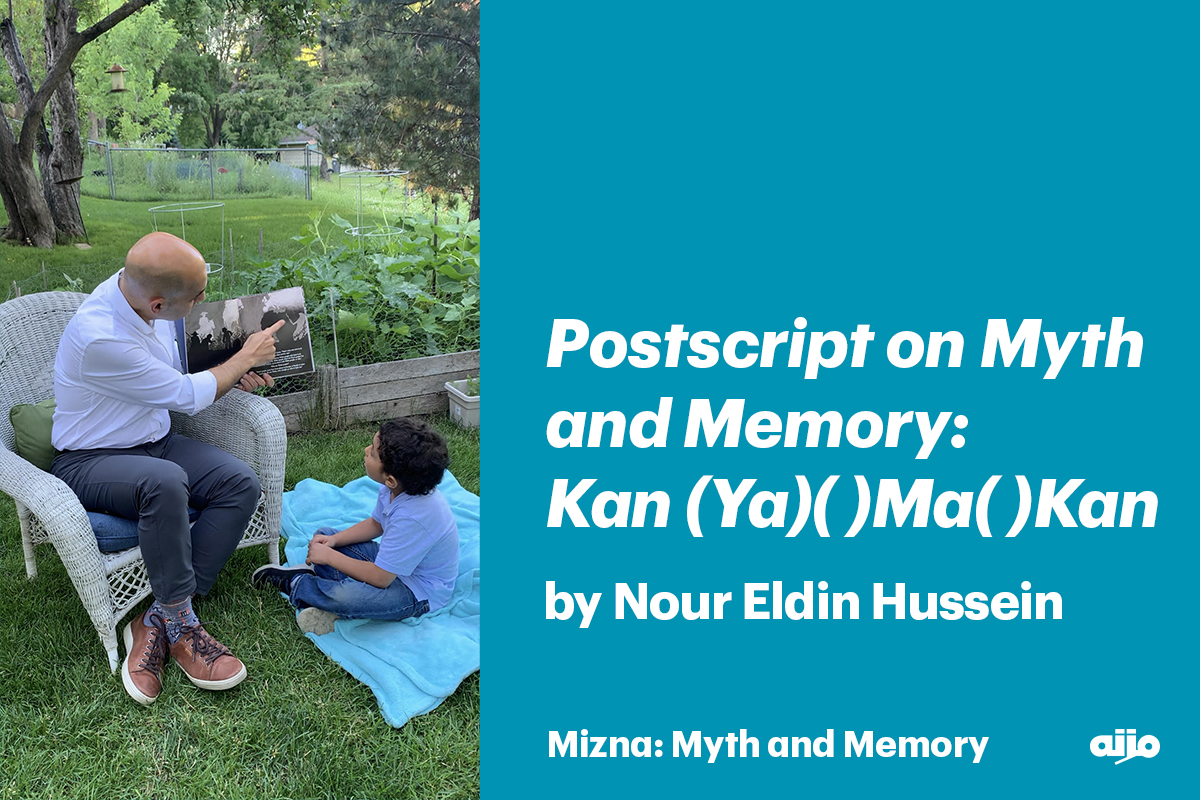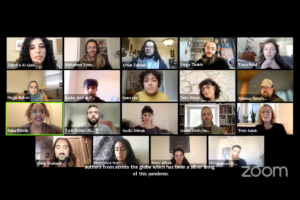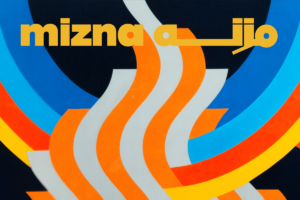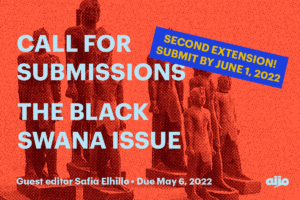
October 5, 2023
Postscript on Myth and Memory: Kan (Ya)( )Ma( )Kan
by Nour Eldin Hussein
When and where does the folk- or fairytale take place? For those familiar with a Western, specifically Anglophone, folk tradition, the answer comes easy: “once upon a time, in a land far, far, away.” To incant the trademark inaugural phrase of myth and folklore is to reanimate an atrophied collective imagination, and command it speak of a reality long gone. Just as “happily ever after” bids adieu, “once upon a time” bids entry into a kind of nostalgia, while also signaling the specific genre of that nostalgia—that is, the genre of folk- or fairytale. In this respect, the folkloric stock phrase is not unique to the Anglophone tradition: a quick scroll through the Wikipedia page for the phrase “once upon a time” reveals a gamut of functionally equivalent analogues spanning folk traditions the world over. In the Arabic rendition, that introductory flourish runs approximately along the lines of kān yā mā kān.
“Functionally equivalent analogue” is perhaps the least presumptive way to put it, as neither phrase may be called a translation of the other—indeed, it would be a mistake of mischaracterization to do so. Though kān yā mā kān regularly finds itself anchored to its English counterpart in translated anthologies of Arabic folktales as a convenient touchstone for the unacquainted, the two opening phrases mutually disagree on the answer to the question of time and place. This may be seen in the common translation Western folklorists, ethnographers, and translators give to kān yā mā kān in English—“there was, or there was not”—which recognizes a certain temporal and spatial tension preventing simple interchangeability. The two phrases specifically disagree on the question of where the audience is in relation to the folktales they hail: on one hand, “once upon a time” constructs a world beyond the reach of the audience by way of complete temporal and spatial unknowability, a world so irretrievable that the belief of the audience becomes irrelevant; the world of reality and that of the story exist independently.1 In fact this exclusion of the audience is the generic characteristic of folklore,2 differentiating it from generic myth which does seek to insinuate the audience in the conspiracy of its world. Kān yā mā kān, on the other hand, seems to do both: though it ushers in the ancestral world of a folk- or fairytale, it implies in the same breath a measure of continuity with lived reality. Far from the abstractions of “once upon a time,” kān yā mā kān sits plausibly, tangibly close by.
That is, of course, assuming we place blind trust in the common translation, or even in kān yā mā kān itself. Just as Maria Nikolajeva cites, “once upon a time, not your time, not my time,” “East of the sun, West of the moon,” and “in the reign of King Arthur,” as variations on the theme, Dwight F. Reynolds hints at the existence of “dozens” of renditions of kān yā mā kān, ranging from chān wa mā chān (“there was and there was not”), to kān mā kān ḥattā kān (“there was, there was not, until there was”). 3 Some versions exploit Arabic’s syntactic ambiguities, processing the particle yā not as the conjunction “or,” but as the particle for direct address of an audience, producing a kān yā makān where the story is literally addressed to its own setting. In fact it is more often than not that syntactic flexibility allows for a wide degree of play, as exampled by the kān mā kān referenced in Inea Bushnaq’s collection of Arab folktales,4 which is so nonprescriptive that it offers itself up simultaneously to two different readings: “there was[,] there was not,” or, an altogether different meaning, one which underscores the absolute truth of the tale about to unfold—“what happened happened.” Yet more intricacies insert themselves when considering Arabic folklore’s preference for the regional, colloquial register over that of the high literary formalism of fusha or Modern Standard Arabic.5 The diversities of the former here combine with Arabic’s syntactic playfulness to unleash a variety of additional interpretive forces: my native Egyptian Arabic, for instance, privileges the emphatic insistence of its own kān yāmā kān—“there was, O’ how there was!”—over the indecisiveness of its siblings.6 Thus the Iraqi-accented chān—and all the connotations of class that attend it—asserts itself over the more normative kān. All of this, of course, assumes kān yā mā kān is the basic introductory template in the first place: Sheharazad leads her tales in 1001 Arabian Nights with a simple balaghnī or “it has been relayed to me [that]”, while Inea Bushnaq’s compendium contains instances where the only introductory phrase in use is a simple “once.”7
So the obvious question: which one is the “real” kān yā mā kān? What should be the most authentic translation? When and where and what, exactly, is the Arabic folktale—fact or fiction?
Certainly there have been attempts at an answer. Writing for The New Arab, Basma al-Khatib asserts that “there was, or there was not” is indeed correct, based upon the prevalence of similar themes of uncertainty prevalent in many folktales; this is the understanding most preferred by those in the business of translating Arabic folklore.8 By contrast, however, the Academy of the Arabic Language Online, a Saudi-based linguistic organization, rules that there is more grammatical weight behind yā as direct address of a subject rather than yā as “or.” Both approaches flounder against my own intuitive, Egyptian understanding of the phrase as kān yāmā kān.
At an impasse of this kind, perhaps it’s wisest to reconsider the instinct to unify altogether and recall that translation is always political, always situated. As Ibrahim Muhawi argues, to translate the Arabic folktale is to impose canonicity and univocality on a body of work that is by its very nature internally variegated and plural in its manifestations. “An excellent guarantee against orthodoxy,” variation in the Arabic folkloric canon comes to form a mode of collective composition where authenticity stems not from the triumphant excavation of a uniform, authoritative text, but from the very presence of variants themselves. In other words, variation and inconsistency are the very stuff of historical agency made manifest; it is evidence of an empowered historical subject modifying the Arabic folkloric tradition as they see fit. To search for and acknowledge only one variant of kān yā mā kān is to arbitrarily elevate only one historical agent over others. Thus my Egyptian kān yāmā kān cannot be any more or less legitimate than the Baghdadi Christian chān wa mā chān, which cannot be any more or less legitimate than a Sudanese kān yā makān, and so on.
Whether kān yā mā kān is or is not, here is its call to action: to see space where there are holes, to hear cacophony in the single voice. It is permission to retell—to reinterpret, remix, embellish just a little, to understand the world’s distant past and lived present your way. From Sadik Kwaish Alfraji’s retelling of the memory of exile in Ali’s Boat to the uncertain recollection of a certain lemon tree in Samia Saliba’s “beit/bait”— “not there // but over there. behind the fence”— it is around kān yā mā kān that Myth and Memory coalesces.
- Maria Nikolajeva. “Fairy Tale and Fantasy: From Archaic to Postmodern.” Marvels & Tales 17, no. 1 (2003): 141. http://www.jstor.org/stable/41389904. ↩︎
- William Bascom. “The Forms of Folklore: Prose Narratives.” The Journal of American Folklore 78, no. 307 (1965): 5. https://doi.org/10.2307/538099. ↩︎
- Charles A. Ferguson and Frank A. Rice, “Iraqi Children’s Rhymes.” Journal of the American Oriental Society 80 (1960): 335-40, quoted in Dwight Reynolds, Arab Folklore: A Handbook. (Connecticut: Bloomsbury Academic, 2007), 87. ↩︎
- Inea Bushnaq, Arab Folktales. (Cairo: The American University in Cairo Press, 1986), xv ↩︎
- Muhawi Ibrahim, “Between Translation and the Canon: The Arabic Folktale as Transcultural Signifier.” Fabula 41, no. 1-2 (2000): 105-7. ↩︎
- See A Dictionary of Egyptian Arabic, 1st ed. Martin Hinds and El-Said Badawi (Beirut: Librairie du Liban, 1986), s.v. “yāmā” ↩︎
- Bushnaq’s collection in fact sees a diversity of openers, including “one day,” “there are,” “they say,” “did I tell you or did I not tell you [that],” among others. See Bushnaq, pp. 228 for a specific instance of “once”. ↩︎
- Muhawi Ibrahim, “Between Translation and the Canon: The Arabic Folktale as Transcultural Signifier.” Fabula 41, no. 1-2 (2000): 107 ↩︎

Nour Eldin Hussein is an Egyptian essayist, poet, researcher, translator, and fan of the written and spoken word. He currently lives, works, and studies in Minneapolis, where he is pursuing an M.A in Arab cultural studies focusing on the Egyptian rap scene. He maintains a small blog on Substack called the lighted room where he writes about digital culture, art online, and the Arab world.










